A Case Study of Industrial Symbiosis in the Humber Region Using the EPOS Methodology
Abstract
1. Introduction
1.1. European and British Context
1.2. Theoretical Background
- Lack of commitment to sustainable development. It reflects the absence of commitment of managers to develop and participate in symbiosis projects. Several reasons can explain this situation such as the lack of sustainability monitoring systems and targets within the organisation [46], the focus that is only put on maximising the company’s profit rather than the system’s one, the negative connotation about waste, the resistance to organisational changes [48], and the relative lack of knowledge about the value of IS [49].
- Lack of information sharing [44]. Given the confidentiality restrains of industry, sharing data usually implies non-disclosure agreements and intellectual property rights granting protection to a company’s background assets. These constraints hinder the exploration of new connections [47] and limit the discovery of new potential exchanges between companies [50].
- Lack of cooperation and trust is also reported as one major obstacles to the development of IS [44,46]. This barrier relates to the possible fear for any company to depend on another partner [46], especially on the longer term, and it can hamper the discovery of new symbiosis and the development of the whole network. Furthermore, cooperation usually means more constrains for companies because of the lack of flexibility, the emergence of new contractual clauses, the complexification of the current internal processes, the development of new systemic risks that are difficult to manage internally, and the difficulties of sharing the benefits of the IS [51]. An IS facilitator can significantly help improving the trust and cooperation between the partners [44,52].
- Technical infeasibility. The technical feasibility of the symbiosis is a prerequisite to proceed with any symbiosis [44]. The implementation of some symbiosis sometimes requires times and efforts to develop new technologies such as specific treatment and separation processes. The lack of technical knowledge within the industry often becomes the bottleneck to the development of a new project. In addition, the technical feasibility of an IS highly depends on the quantity, the quality and the availability of the exchanged resource [53] and such requirements are sometimes difficult to meet.
- Uncertainty in environmental legislation [44]. This is particularly true when assessing the feasibility of a symbiosis. Companies are often reluctant to pursue IS projects because of the inconsistency, the inflexibility but also the volatility of the environmental regulation and its enforcement [42]. A good example of this, is the difficulty to obtain the approvals for waste reuse projects [44];
- The lack of awareness from communities can also stop to the development of IS projects. Sometimes communities are not conscious of the environmental and social benefits brought by IS and can be reluctant to see an increase in nearby industrial activities [44]. On the other hand, a community with a good knowledge about IS and its potential gains can be a driver for the implementation of an IS project [44].
- Economic infeasibility: the appropriate market conditions should be met in order to create IS opportunities [42]. In some cases, even if the symbiosis proves to be technically feasible and relevant in terms of environment and social performance, it cannot proceed because additional transaction costs are too high [54,55] and economic gains are too insignificant for the project to meet the cost-benefit requirements (low return on investment, high payback time).
1.3. Focus of this Paper
2. Methodology
2.1. The EPOS Context and Case Study Selection Process
2.2. The EPOS Methodology
- Value(s) created:
- ⚬
- New revenues are typically created by selling underutilised resources. The value of these revenues depends on how the resources are valorised (as heat, combustible or material), the type of substituted resource and their quality. They can be assessed by comparing resources with their equivalents on the market;
- ⚬
- Costs avoided are related to public bodies (e.g., taxes) or private entities (e.g., end-of-pipe treatment) and must be anticipated during scope definition.
- Value(s) destroyed:
- ⚬
- New costs depend on the type of the new symbiosis. They can be inherent to its creation (e.g., transport, transaction costs, etc.) or optional (e.g., new equipment or on-site operations). They are pre-identified in scope definition and refined using technology databases [76];
- ⚬
- Value(s) missed are either generated upstream in the value chain of the substituted resource (e.g., supply of raw materials) and downstream in the value chain of the exchanged resource (e.g., waste treatment).
- The IS project context (economic, regulatory, environmental, local, etc.);
- Pieces of information for the stakeholders and the answer to the question ‘why the organisation needs the IS?’;
- The comparison between the BaU and the other competing projects (advantages/disadvantages);
- How the value proposition of the IS propositions satisfies the organisational needs;
- The evaluation of the impacts on the organisation;
- The assessment of the financial risks.
3. Case Study
3.1. Step 1—LESTS Analysis
- The substitution of a primary fuel in cement kiln by a waste resource (PLF) from the chemical industry;
- The substitution of the calcium carbonate extracted from the cement producer’s quarry by a chalk already extracted by the mineral producer;
- The safe storage of cement kiln dust (CKD) in the mineral producer’s old quarries.
3.2. Step 2—SWOT Analysis
3.3. Step 3—Scope Definition
3.3.1. Mapping of the Set of Stakeholders
- Central: Chemical plant and cement producer;
- Peripheral: Waste handler for the cement producer, treatment facility owner, and transport provider;
- External: Primary fuel supplier of the cement producer, third party currently using the waste stream to produce steam, and broadly the society.
3.3.2. Data Collection
- From an organisational point of view, it clearly appears to be easier to send the PLF to the waste fuel provider of the cement producer rather than to the cement producer directly. This avoids investments in specific on-site storage and reduces costs associated with logistics and management (e.g., quality control). Furthermore, the waste fuel provider owns the required equipment and is highly qualified for such a task;
- The PLF stream needs to be separated at least into two fractions (acid and organic) to avoid any issue when blending the PLF with the current AFs mix and when burning it in the cement kiln. If the PLF can be separated, its acid fraction could be recycled back into the chemical plant. It is important to remind that this treatment step was not foreseen in step 1 or step 2;
- To ensure the PLF treatment and separation, one of the central actors should invest in the required technology, or a third party should be established;
- Interviews revealed the possibility of a 40% increase in the PLF flow rate due to the de-bottlenecking of the chemical plant (e.g., specific areas of the process limiting the flow of product have been identified and optimised so that the overall capacity in the plant can be increased);
- The stream can be transported by truck or boat;
- The steam provider will have to replace the PLF stream by a conventional fuel. In this case, natural gas is assumed to substitute PLF.
3.3.3. BaU and Symbiosis Scenarios
3.4. Step 4—Value Mapping
- The PLF stream is replaced by natural gas in the steam boilers;
- The PLF organic fraction that is sent to the cement producer’s kiln substitutes heavy fuels;
- Treatment operations are required to separate the fractions;
- Transport is needed between the chemical plant and the treatment facility (whole stream, acid and solvent fractions) and between the treatment facility and the cement producer’s AFs provider (organic fraction);
- The acid and solvent fractions substitute primary raw materials at the chemical plant.
3.5. Step 5—Business Model
3.6. Step 6—Business Case
3.7. Step 7—Feasibility Study
- The first option involves four partners: cement producer, waste handler, chemical plant and the third party in charge of the distillation. The organic part of the PLF is blended with the current AFs mix, while steam is produced by using the waste heat from the cement plant and used by the distillation unit. In this scenario, it is likely that the treatment facility will be located next to the cement plant to limit the energy losses of transporting steam from the cement facility to the distillation unit and reduce the transportation costs of the PLF stream;
- The second option only involves the chemical plant and the third party in charge of the distillation. The organic fraction is used as fuel by the third party to produce the steam needed by the distillation unit. This scenario is more likely to happen if the treatment facility is located far away from the cement site;
- The third option involves four partners: the cement producer, waste handler, chemical plant and the third party in charge of the distillation. The distillation unit is using natural gas to separate the PLF stream into three fractions. The organic fraction is sent to the cement producer where it is blended with the current AFs mix. This scenario is similar to the one assessed in the first steps of the case study.
4. Discussion
4.1. Addressing Some of the Barriers to IS
4.2. Comparison with Other Methods and Tools from the Literature
4.3. Limitations and Research Perspectives
5. Conclusions
- Identification of IS opportunities as thirteen IS options were identified in the EPOS Hull cluster;
- Prioritisation of these opportunities according to stakeholders’ goals, needs, and constraints;
- Context analysis with respect to the legal, economic, social, technical, and spatial aspects that ultimately results in the identification of strengths, weaknesses, opportunities and threats of the cluster under consideration;
- Analysis of a wider range of values (economic, environmental, social, and territorial) than the ones generally taken into account during the assessment of IS opportunities. In the case study, the positive and negative impacts of the symbiosis are clearly detailed, revealing the main source of value creation (in terms of economic and environment gains) which is due to an internal recycling.
- Creation of the symbiosis’ business model that clearly highlights what the value propositions are, how they are delivered to the different stakeholders and how the latter can capture these values within their own business. It gives some insights on how the values could be shared and proposes some levers to internalise environmental, social and territorial values if the business model is not economically viable;
- Draft of preliminary business cases devoted to trigger the interest of the industries’ decision-makers. In the case study, the symbiosis business case helped raising the interest of the chemical company, which then decided to start a feasibility study;
- Detailed and technical analysis of synergies without asking for confidential data from the other stakeholders (blueprints).
- Develop innovative (non-)market-based mechanisms that could facilitate the efficient integration of non-economic values in the business models of companies. Examples of such initiatives can be the implementation of local or circular labels, the enactment of public procurement targeting materials with such labels, or the unlocking of subsidies based on the expected (positive) externalities brought to the community;
- Improve the traceability of products along the entire value chain to give the opportunity to upstream actors, such as heavy industries, to differentiate from competitors in terms of sustainability performance;
- Finance or mandate certified ‘material audits’ (similar to energy audits) that could provide industries with strategies to improve the use of their resources or to implement eco-design.
- Train and educate practitioners through proactive workshops on the benefits brought by sustainable business models. These seminars should be based on real and successful experiences as the one introduced in this paper.
Supplementary Materials
Author Contributions
Funding
Acknowledgments
Conflicts of Interest
Abbreviations
| AF | Alternative Fuel |
| BaU | Business as Usual |
| BEIS | Department for Business, Energy and Industrial Strategy |
| EPOS | Enhanced energy and resource Efficiency and Performance in process industry Operations via onsite and cross-sectorial Symbiosis |
| EU | European Union |
| GCC | Grand Composite Curve |
| HISP | Humber Industrial Symbiosis Programme |
| ICT | Information and Communication Technology |
| IE | Industrial Ecology |
| IS | Industrial Symbiosis |
| LCT | Life Cycle Thinking |
| LESTS | Legal, Economic, Spatial, Technical and Social PLF primary liquid fuel |
| PM | Particulate Matter |
| SWOT | Strengths, Weaknesses, Opportunities, Threats |
Appendix A
| Level of interest | 1 | 2 | 3 | 4 | 5 |
|---|---|---|---|---|---|
| Technical suitability | Technically, it does not make sense for the specific production system | Complex changes in the existing infrastructure are required (implying unreasonably high costs) | Technically, it makes sense for this specific production system | Infrastructure and/or other conditions are fulfilled to some extent or can be improved without major challenges | No major infrastructural challenges exist, and other conditions are fulfilled |
| Organisational suitability | Not in line with the organisation’s goals and strategies | Organisational resources (time, budget, etc.) are not available, and/or should not be directed at this measure | Partially in line with the organisation’s goals and strategies and is considered relatively important | In line with the organisation’s goals and strategies. The necessary organisational resources (time, budget, etc.) are not available, but this could be changed | The measure is considered important by the organisation and the necessary organisational resources (time, budget, etc.) can be allocated to this measure |
References
- European Commission. The Road from Paris: Assessing the Implications of the Paris Agreement and Accompanying the Proposal for a Council Decision on the Signing, on behalf of the European Union, of the Paris Agreement Adopted under the United Nations Framework Convention on Climate Change; European Commission: Brussels, Belgium, 2016. [Google Scholar]
- Bourg, D.; Fragnière, A. La Pensée Ecologique: Une Anthologie; L’écologie en Questions; Presses Universitaires de France: Paris, France, 2014; ISBN 978-2-13-058444-5. [Google Scholar]
- Ellen MacArthur Foundation. Towards the Circular Economy, Vol. 1: Economic and Business Rationale for a Circular Economy; Ellen MacArthur Foundation: Cowes, UK, 2012. [Google Scholar]
- Sana, F. L’économie Circulaire: Changement Complet de Paradigme Economique? Pour la Solidarité: Bruxelles, Belgium, 2014; p. 24. [Google Scholar]
- Bourguignon, D. Closing the Loop: New Circular Economy Package; European Parliament: Brussels, Belgium, 2016; p. 9. [Google Scholar]
- European Commission. Implementation of the Circular Economy Action Plan; European Commission: Brussels, Belgium, 2019. [Google Scholar]
- Ellen MacArthur Foundation. Towards the Circular Economy, Vol. 2: Opportunities for the Consumer Goods Sector; Ellen MacArthur Foundation: Cowes, UK, 2013. [Google Scholar]
- Ellen MacArthur Foundation. Towards the Circular Economy, Vol. 3: Accelerating the Scale-Up across Global Supply Chains; Ellen MacArthur Foundation: Cowes, UK, 2014. [Google Scholar]
- Wentworth, J.; Burgon, J. Designing a Circular Economy; Parliamentary Office of Science and Technology: London, UK, 2016. [Google Scholar]
- House of Commons Environmental Audit Committee. Growing a Circular Economy: Ending the Throwaway Society; Authority of the House of Commons: London, UK, 2014. [Google Scholar]
- HM Government. Growing a Circular Economy: Ending the Throwaway Society: Government Response to the Committee’s Third Report of Session 2014–2015-Eighth Special Report of Session 2014–2015; HM Government: London, UK, 2014.
- Murray, A.; Skene, K.; Haynes, K. The Circular Economy: An Interdisciplinary Exploration of the Concept and Application in a Global Context. J. Bus. Ethics 2017, 140, 369–380. [Google Scholar] [CrossRef]
- Department for Business, Energy & Industrial Strategy. Industrial Decarbonisation and Energy Efficiency Action Plans: Summary Document; Department for Business, Energy & Industrial Strategy: London, UK, 2017; p. 6.
- Department of Energy and Climate Change; Department for Business, Innovation and Skills. Industrial Decarbonisation & Energy Efficiency Roadmaps to 2050: Chemicals; Department for Business, Innovation and Skills: London, UK, 2015.
- Department for Business, Energy & Industrial Strategy. Chemicals Sector: Industrial Decarbonisation and Energy Efficiency Roadmap Action Plan; Department for Business, Energy & Industrial Strategy: London, UK, 2017.
- Department for Business, Energy & Industrial Strategy. Cement Sector: Industrial Decarbonisation and Energy Efficiency Roadmap Action Plan; Department for Business, Energy & Industrial Strategy: London, UK, 2017.
- British Standard Institution. BS 8001:2017—Framework for Implementing the Principles of the Circular Economy in Organizations. Guide; BSI: London, UK, 2017; ISBN 978 0 580 92644 0. [Google Scholar]
- HM Government. The UK Low Carbon Transition Plan: National Strategy for Climate and Energy; HM Government: London, UK, 2009; ISBN 978-0-10-850839-4.
- Velenturf, A.P.M. Initiating resource partnerships for industrial symbiosis. Reg. Stud. Reg. Sci. 2017, 4, 117–124. [Google Scholar] [CrossRef]
- Jensen, P.D. The role of geospatial industrial diversity in the facilitation of regional industrial symbiosis. Resour. Conserv. Recycl. 2016, 107, 92–103. [Google Scholar] [CrossRef]
- Penn, A.S.; Jensen, P.D.; Woodward, A.; Basson, L.; Schiller, F.; Druckman, A. Sketching a network portrait of the humber region. Complexity 2014, 19, 54–72. [Google Scholar] [CrossRef]
- Humber Local Enterprise Partnership. Humber Strategic Economic Plan 2014–2020; Humber Local Enterprise Partnership: Humber, UK, 2014. [Google Scholar]
- Penn, A.S.; Knight, C.J.K.; Lloyd, D.J.B.; Avitabile, D.; Kok, K.; Schiller, F.; Woodward, A.; Druckman, A.; Basson, L. Participatory Development and Analysis of a Fuzzy Cognitive Map of the Establishment of a Bio-Based Economy in the Humber Region. PLoS ONE 2013, 8, e78319. [Google Scholar] [CrossRef] [PubMed]
- Yorkshire and the Humber Regional Committee. Carbon Emissions in the Yorkshire and Humber Region; House of Commons: London, UK, 2010.
- Strane Innovation SAS. D6.1—EPOS Tool Market Study; Strane Innovation SAS: Paris, France, 2016. [Google Scholar]
- Bruel, A.; Kronenberg, J.; Troussier, N.; Guillaume, B. Linking Industrial Ecology and Ecological Economics: A Theoretical and Empirical Foundation for the Circular Economy. J. Ind. Ecol. 2019, 23, 12–21. [Google Scholar] [CrossRef]
- Ghisellini, P.; Cialani, C.; Ulgiati, S. A review on circular economy: The expected transition to a balanced interplay of environmental and economic systems. J. Clean. Prod. 2016, 114, 11–32. [Google Scholar] [CrossRef]
- Deutz, P.; Ioppolo, G. From Theory to Practice: Enhancing the Potential Policy Impact of Industrial Ecology. Sustainability 2015, 7, 2259–2273. [Google Scholar] [CrossRef]
- Chertow, M.R.; Ehrenfeld, J.R. Organizing Self-Organizing Systems. J. Ind. Ecol. 2012, 16, 13–27. [Google Scholar] [CrossRef]
- Lombardi, D.R.; Laybourn, P. Redefining Industrial Symbiosis. J. Ind. Ecol. 2012, 16, 28–37. [Google Scholar] [CrossRef]
- Chertow, M.R. INDUSTRIAL SYMBIOSIS: Literature and Taxonomy. Annu. Rev. Energy Environ. 2000, 25, 313–337. [Google Scholar] [CrossRef]
- Mirata, M.; Emtairah, T. Industrial symbiosis networks and the contribution to environmental innovation: The case of the Landskrona industrial symbiosis programme. J. Clean. Prod. 2005, 13, 993–1002. [Google Scholar] [CrossRef]
- Van Eetvelde, G.; Dierick, B.; Allaert, G.; Vanden Abeele, P.; Verhoestraete, D.; Matthyssen, D.; De Zutter, B.; Deridder, K.; De Roeck, V.; Devos, D.; et al. Groeiboek Duurzame Bedrijventerreinen, Technisch, Economisch, Juridisch and Ruimtelijk Bekeken; Vanden Broele: Gent, Belgium, 2005. [Google Scholar]
- Van Eetvelde, G. Industrial Symbiosis. In Resource Efficiency of Processing Plants; John Wiley & Sons, Ltd.: Hoboken, NJ, USA, 2018; pp. 441–469. ISBN 978-3-527-80415-3. [Google Scholar]
- Van Eetvelde, G.; Deridder, K.; Segers, S.; Maes, T.; Crivits, M. Sustainability scanning of eco-industrial parks. In Proceedings of the 11th European Roundtable on Sustainable Consumption and Production, Basel, Switzerland, 20–22 June 2007. [Google Scholar]
- Desrochers, P.; Szurmak, J. Long Distance Trade, Locational Dynamics and By-Product Development: Insights from the History of the American Cottonseed Industry. Sustainability 2017, 9, 579. [Google Scholar] [CrossRef]
- Desrochers, P. Market Processes and the Closing of ‘Industrial Loops’. J. Ind. Ecol. 2000, 4, 29–43. [Google Scholar] [CrossRef]
- Lowe, E.A.; Evans, L.K. Industrial ecology and industrial ecosystems. J. Clean. Prod. 1995, 3, 47–53. [Google Scholar] [CrossRef]
- Mirata, M. Experiences from early stages of a national industrial symbiosis programme in the UK: Determinants and coordination challenges. J. Clean. Prod. 2004, 12, 967–983. [Google Scholar] [CrossRef]
- Chertow, M.R. “Uncovering” Industrial Symbiosis. J. Ind. Ecol. 2007, 11, 11–30. [Google Scholar] [CrossRef]
- Symbiosis Institute. Available online: http://www.symbiosis.dk/ (accessed on 23 July 2019).
- Lombardi, R. Non-technical barriers to (and drivers for) the circular economy through industrial symbiosis: A practical input. Econ. Policy Energy Environ. 2017. [Google Scholar] [CrossRef]
- Desrochers, P. Industrial symbiosis: The case for market coordination. J. Clean. Prod. 2004, 12, 1099–1110. [Google Scholar] [CrossRef]
- Golev, A.; Corder Glen, D.; Giurco Damien, P. Barriers to Industrial Symbiosis: Insights from the Use of a Maturity Grid. J. Ind. Ecol. 2014, 19, 141–153. [Google Scholar] [CrossRef]
- Tudor, T.; Adam, E.; Bates, M. Drivers and limitations for the successful development and functioning of EIPs (eco-industrial parks): A literature review. Ecol. Econ. 2007, 61, 199–207. [Google Scholar] [CrossRef]
- Fichtner, W.; Tietze-Stöckinger, I.; Frank, M.; Rentz, O. Barriers of interorganisational environmental management: Two case studies on industrial symbiosis. Prog. Ind. Ecol. Int. J. 2005, 2, 73–88. [Google Scholar] [CrossRef]
- Mortensen, L.; Kørnøv, L. Critical factors for industrial symbiosis emergence process. J. Clean. Prod. 2019, 212, 56–69. [Google Scholar] [CrossRef]
- Domenech, T.; Bleischwitz, R.; Doranova, A.; Panayotopoulos, D.; Roman, L. Mapping Industrial Symbiosis Development in Europe typologies of networks, characteristics, performance and contribution to the Circular Economy. Resour. Conserv. Recycl. 2019, 141, 76–98. [Google Scholar] [CrossRef]
- Van Berkel, R.; Willems, E.; Lafleur, M. Development of an industrial ecology toolbox for the introduction of industrial ecology in enterprises—I. J. Clean. Prod. 1997, 5, 11–25. [Google Scholar] [CrossRef]
- Kastner, C.A.; Lau, R.; Kraft, M. Quantitative tools for cultivating symbiosis in industrial parks; a literature review. Appl. Energy 2015, 155, 599–612. [Google Scholar] [CrossRef]
- Ashton, W.S.; Chopra, S.S.; Kashyap, A.R. Life and Death of Industrial Ecosystems. Sustainability 2017, 9, 605. [Google Scholar] [CrossRef]
- Siskos, I.; Wassenhove, L.N.V. Synergy Management Services Companies: A New Business Model for Industrial Park Operators. J. Ind. Ecol. 2017, 21, 802–814. [Google Scholar] [CrossRef]
- Vladimirova, D.; Miller, K.; Evans, S. Lessons Learnt and Best Practices for Enhancing Industrial Symbiosis in the Process Industry; Scaler: Brussels, Belgium, 2018. [Google Scholar]
- Homrich, A.S.; Galvão, G.; Abadia, L.G.; Carvalho, M.M. The circular economy umbrella: Trends and gaps on integrating pathways. J. Clean. Prod. 2018, 175, 525–543. [Google Scholar] [CrossRef]
- Deutz, P.; Gibbs, D. Industrial Ecology and Regional Development: Eco-Industrial Development as Cluster Policy. Reg. Stud. 2008, 42, 1313–1328. [Google Scholar] [CrossRef]
- Ogé, S.; Mendez Alva, F.; Bredimas, A. Industrial Symbiosis Guide for Identifying Opportunities & Conceptualising Business Relations; ESCP Europe Business School: Berlin, Germany, 2019; p. 30. [Google Scholar]
- Cervo, H.; Bungener, S.; Méchaussie, E.; Kantor, I.; Zwaenepoel, B.; Maréchal, F.; Van Eetvelde, G. Virtual Sector Profiles for Innovation Sharing in Process Industry—Sector 01: Chemicals. In Proceedings of the Sustainable Design and Manufacturing, Bologna, Italy, 26–28 April 2017; Campana, G., Howlett, R.J., Setchi, R., Cimatti, B., Eds.; Springer: Cham, Switzerland, 2017; Volume 68, pp. 569–578. [Google Scholar]
- Cervo, H.; Ferrasse, J.-H.; Descales, B.; Van Eetvelde, G. Blueprint: A methodology facilitating data exchanges to enhance the detection of industrial symbiosis opportunities—Application to a refinery. Chem. Eng. Sci. 2020, 211, 115254. [Google Scholar] [CrossRef]
- Yeo, Z.; Masi, D.; Low, J.S.C.; Ng, Y.T.; Tan, P.S.; Barnes, S. Tools for promoting industrial symbiosis: A systematic review. J. Ind. Ecol. 2019, 23, 1087–1108. [Google Scholar] [CrossRef]
- EPOS. Enhanced Energy and Resource Efficiency and Performance in Process Industry Operations via Onsite and Cross-Sectorial Symbiosis|SPIRE. Available online: https://www.spire2030.eu/epos (accessed on 3 December 2018).
- Green, K.; Randles, S. Industrial Ecology and Spaces of Innovation; Social and Political Science 2010 and before; Edward Elgar Publishing Limited: Cheltenham, UK, 2006; ISBN 978-1-84542-097-0. [Google Scholar]
- Morales, E.M.; Diemer, A.; Cervantes, G.; Carrillo-González, G. “By-product synergy” changes in the industrial symbiosis dynamics at the Altamira-Tampico industrial corridor: 20 Years of industrial ecology in Mexico. Resour. Conserv. Recycl. 2019, 140, 235–245. [Google Scholar] [CrossRef]
- Laybourn, P.; Morrissey, M. National Industrial Symbiosis Programme: The Pathway to a Low Carbon Sustainable Economy; International Synergies Ltd.: Birmingham, UK, 2009; ISBN 978-0-9564235-0-4. [Google Scholar]
- Velenturf, A.P.M. Promoting industrial symbiosis: Empirical observations of low-carbon innovations in the Humber region, UK. J. Clean. Prod. 2016, 128, 116–130. [Google Scholar] [CrossRef]
- Grant, G.B.; Seager, T.P.; Massard, G.; Nies, L. Information and Communication Technology for Industrial Symbiosis. J. Ind. Ecol. 2010, 14, 740–753. [Google Scholar] [CrossRef]
- Maqbool, A.S.; Piccolo, G.E.; Zwaenepoel, B.; Eetvelde, G.V. A Heuristic Approach to Cultivate Symbiosis in Industrial Clusters Led by Process Industry. In Proceedings of the Sustainable Design and Manufacturing, Bologna, Italy, 26–28 April 2017; Springer: Cham, Switzerland, 2017; pp. 579–588. [Google Scholar]
- Hill, T.; Westbrook, R. SWOT analysis: It’s time for a product recall. Long Range Plann. 1997, 30, 46–52. [Google Scholar] [CrossRef]
- Baas, L.W.; Boons, F.A. An industrial ecology project in practice: Exploring the boundaries of decision-making levels in regional industrial systems. J. Clean. Prod. 2004, 12, 1073–1085. [Google Scholar] [CrossRef]
- European Commission. Reference Documents under the IPPC Directive and the IED. Available online: http://eippcb.jrc.ec.europa.eu/reference/ (accessed on 5 December 2018).
- Chertow, M.R.; Lombardi, D.R. Quantifying Economic and Environmental Benefits of Co-Located Firms. Environ. Sci. Technol. 2005, 39, 6535–6541. [Google Scholar] [CrossRef]
- Chopra, S.S.; Khanna, V. Understanding resilience in industrial symbiosis networks: Insights from network analysis. J. Environ. Manag. 2014, 141, 86–94. [Google Scholar] [CrossRef]
- Maillefert, M.; Robert, I. Coopération et construction des territoires: Quels leviers communs autour de l’écologie industrielle et de l’économie de la fonctionnalité? In Proceedings of the Territoires Méditerranéens: Agriculture, Alimentation et Villes, Montpellier, France, 7–9 July 2015; p. 17. [Google Scholar]
- Bocken, N.M.P.; Rana, P.; Short, S.W. Value mapping for sustainable business thinking. J. Ind. Prod. Eng. 2015, 32, 67–81. [Google Scholar] [CrossRef]
- Bocken, N.; Short, S.; Rana, P.; Evans, S. A Value Mapping Tool for Sustainable Business Modelling; Emerald Group Publishing Limited: Bingley, UK, 2013. [Google Scholar]
- Decouzon, C.; Maillefert, M. Evaluer des projets d’écologie industrielle sur des parcs d’activité: Des synergies au territoire. Géogr. Écon. Soc. 2012, 14, 411–434. [Google Scholar] [CrossRef]
- Korona Inzeniring Dd. D3.3—Technology and Management Database for Cross-Sectorial IS; Korona Inzeniring Dd: Ljubljana, Slovenia, 2017. [Google Scholar]
- Simapro SimaPro|The World’s Leading LCA Software. Available online: https://simapro.com/ (accessed on 12 November 2019).
- Ecoinvent Ecoinvent. Available online: https://www.ecoinvent.org/ (accessed on 12 November 2019).
- Pizzol, M.; Weidema, B.; Brandão, M.; Osset, P. Monetary valuation in Life Cycle Assessment: A review. J. Clean. Prod. 2015, 86, 170–179. [Google Scholar] [CrossRef]
- Nahapiet, J.; Ghoshal, S. Social Capital, Intellectual Capital, and the Organizational Advantage. Acad. Manag. Rev. 1998, 23, 242–266. [Google Scholar] [CrossRef]
- Dussuc, B.; Geindre, S. Capital Social, Théorie des Réseaux Sociaux et Recherche en PME: Une Revue de la Littérature; 11ème congrès CIFEPME (Congrès International francophone en entrepreunariat et PME), Brest, France, Octobre 2012; CIFEPME: Brest, France, 2012. [Google Scholar]
- OECD. OECD Territorial Outlook; OECD Publications: Paris, France, 2001; ISBN 92-64-18602-6. [Google Scholar]
- Lacquement, G.; Chevalier, P. Capital territorial et développement des territoires locaux, enjeux théoriques et méthodologiques de la transposition d’un concept de l’économie territoriale à l’analyse géographique. Ann. Geogr. 2016, 5, 490–518. [Google Scholar] [CrossRef]
- Camagni, R. Compétitivité territoriale: La recherche d’avantages absolus. Reflets Perspect. Econ. 2006, Tome XLV, 95–115. [Google Scholar] [CrossRef]
- Camagni, R. Modelling Features of Regional Development and the Concept of Territorial Capital; Colloquium on Sustainability, Disparities and Polycentricity: Praha, Czech Republic, 2009. [Google Scholar]
- Maillefert, M.; Robert, I. Nouveaux modèles économiques et création de valeur territoriale autour de l’économie circulaire, de l’économie de la fonctionnalité et de l’écologie industrielle. Rev. DEcon. Reg. Urbaine 2017, 5, 905–934. [Google Scholar] [CrossRef]
- Osterwalder, A.; Pigneur, Y. Business Model—Nouvelle Génération: Un Guide pour Visionnaires, Révolutionnaires et Challengers; Pearson: London, UK, 2017; ISBN 978-2-7440-6688-7. [Google Scholar]
- Joyce, A.; Paquin, R.L. The triple layered business model canvas: A tool to design more sustainable business models. J. Clean. Prod. 2016, 135, 1474–1486. [Google Scholar] [CrossRef]
- Schaltegger, S.; Hansen, E.G.; Lüdeke-Freund, F. Business Models for Sustainability: Origins, Present Research, and Future Avenues. Organ. Environ. 2016, 29, 3–10. [Google Scholar] [CrossRef]
- EPOS. EPOS User Club. Available online: https://epos.userecho.com/ (accessed on 19 February 2019).
- Kantor, I.; Wallerand, A.S.; Kermani, M.; Bütün, H.; Santecchia, A.; Norbert, R.; Cervo, H.; Arias, S.; Wolf, F.; Van Eetvelde, G.; et al. Thermal profile construction for energy-intensive industrial sectors. In Proceedings of the Proceedings of ECOS 2018—The 31st International Conference on Efficiency, Cost, Optimization, Simulation and Environmental Impact of Energy Systems, Guimarães, Portugal, 17–22 June 2018. [Google Scholar]
- Linnhoff, B.; Hindmarsh, E. The pinch design method for heat exchanger networks. Chem. Eng. Sci. 1983, 38, 745–763. [Google Scholar] [CrossRef]
- Kantor, I. An Introduction to Virtual Sector Profiles; EPFL: Lausanne, Switzerland, 2019. [Google Scholar]
- Wolf, F. Mineral Blueprint; Omya: Offflingen, Switzerland, 2019. [Google Scholar]
- Maqbool, A.S.; Mendez Alva, F.; Van Eetvelde, G. An Assessment of European Information Technology Tools to Support Industrial Symbiosis. Sustainability 2019, 11, 131. [Google Scholar] [CrossRef]
- Luciano, A.; Barberio, G.; Mancuso, E.; Sbaffoni, S.; La Monica, M.; Scagliarino, C.; Cutaia, L. Potential Improvement of the Methodology for Industrial Symbiosis Implementation at Regional Scale. Waste Biomass Valorization 2016, 7, 1007–1015. [Google Scholar] [CrossRef]
- Trokanas, N.; Cecelja, F.; Raafat, T. Semantic input/output matching for waste processing in industrial symbiosis. Comput. Chem. Eng. 2014, 66, 259–268. [Google Scholar] [CrossRef]
- Cecelja, F.; Raafat, T.; Trokanas, N.; Innes, S.; Smith, M.; Yang, A.; Zorgios, Y.; Korkofygas, A.; Kokossis, A. e-Symbiosis: Technology-enabled support for Industrial Symbiosis targeting Small and Medium Enterprises and innovation. J. Clean. Prod. 2015, 98, 336–352. [Google Scholar] [CrossRef]
- Aid, G.; Eklund, M.; Anderberg, S.; Baas, L. Expanding roles for the Swedish waste management sector in inter-organizational resource management. Resour. Conserv. Recycl. 2017, 124, 85–97. [Google Scholar] [CrossRef]
- Bredimas, A.; Ogé, S.; Quintana, J.-B.; Camuzeaux, E. Material and Energy flow management tools overview for Circular economy—Software for Industrial Symbiosis. Extended abstract; Strane Innovation SAS: Paris, France, June 2019; p. 14. [Google Scholar]
- Van Capelleveen, G.; Amrit, C.; Yazan, D.M. A Literature Survey of Information Systems Facilitating the Identification of Industrial Symbiosis. In From Science to Society; Otjacques, B., Hitzelberger, P., Naumann, S., Wohlgemuth, V., Eds.; Springer International Publishing: Cham, Switzerland, 2018; pp. 155–169. [Google Scholar]
- Benedetti, M.; Holgado Granados, M.; Evans, S. Prototype Library of Case Studies Linked to a Waste Database; Maestri: Brussels, Belgium, 2017. [Google Scholar]
- Fraccascia, L.; Magno, M.; Albino, V. Business models for industrial symbiosis: A guide for firms. In Proceedings of the Procedia Environmental Science, Engineering and Management, Rimini Fiera, Italy, 8–11 November 2016; Volume 2, pp. 83–93. [Google Scholar]
- Magnusson, T.; Andersson, H.; Ottosson, M. Industrial ecology and the boundaries of the manufacturing firm. J. Ind. Ecol. 2019, 23, 1211–1225. [Google Scholar] [CrossRef]
- Fraccascia, L.; Giannoccaro, I.; Albino, V. Business models for industrial symbiosis: A taxonomy focused on the form of governance. Resour. Conserv. Recycl. 2019, 146, 114–126. [Google Scholar] [CrossRef]
- Tsvetkova, A.; Gustafsson, M. Business models for industrial ecosystems: A modular approach. J. Clean. Prod. 2012, 29–30, 246–254. [Google Scholar] [CrossRef]
- Shafer, S.M.; Smith, H.J.; Linder, J.C. The power of business models. Bus. Horiz. 2005, 48, 199–207. [Google Scholar] [CrossRef]
- Galper, J. Three Business Models for the Stock Exchange Industry. J. Invest. 2001, 10, 70–78. [Google Scholar] [CrossRef]
- Gebauer, J.; Ginsburg, M. The US Wine Industry and the Internet: An Analysis of Success Factors for Online Business Models. Electron. Mark. 2003, 13, 59–66. [Google Scholar]
- Baden-Fuller, C. Strategic Innovation, Corporate Entrepreneurship and Matching Outside-in to Inside-out Approaches to Strategy Research1. Br. J. Manag. 1995, 6, S3–S16. [Google Scholar] [CrossRef]
- Chesbrough, H.; Garman, A.R. Harvard Business Review; Harvard Business Publishing: Cambridge, MA, USA, 2009. [Google Scholar]
- Simanis, E.; Hart, S. Innovation from the Inside Out. MIT Sloan Management Review. 1 July 2009. Available online: https://sloanreview.mit.edu/article/innovation-from-the-inside-out (accessed on 5 December 2019).
- Simon, H.A. The Architecture of Complexity. Proc. Am. Philos. Soc. 1962, 106, 467–482. [Google Scholar]
- Lüdeke-Freund, F. Towards a Conceptual Framework of “Business Models for Sustainability”; Social Science Research Network: Rochester, NY, USA, 2010. [Google Scholar]
- Boons, F.; Spekkink, W.; Mouzakitis, Y. The dynamics of industrial symbiosis: A proposal for a conceptual framework based upon a comprehensive literature review. J. Clean. Prod. 2011, 19, 905–911. [Google Scholar] [CrossRef]
- Bachmann, T.M. Optimal Pollution: The Welfare Economic Approach to Correct Market Failures. In Encyclopedia of Environmental Health; Nriagu, J.O., Ed.; Elsevier: Burlington, MA, USA, 2011; pp. 264–274. ISBN 978-0-444-52272-6. [Google Scholar]
- Frischknecht, R. Life cycle inventory analysis for decision-making: Scope-Dependent Inventory System Models and Context-Specific Joint Product Allocation. Int. J. Life Cycle Assess. 1998, 3, 67. [Google Scholar] [CrossRef]
- Weidema, B.P. New Developments in the Methodology for LCA. In Proceedings of the 3rd International Conference on Ecobalance, Tsukuba, Japan, 25–27 November 1998; Springer: Tsukuba, Japan, 1998. [Google Scholar]
- Loiseau, E.; Junqua, G.; Roux, P.; Maurel, P.; Bellon-Maurel, V. Évaluation Environnementale de Territoires: Apports, Limites et Adaptation du Cadre Méthodologique de l’Analyse du Cycle de Vie; COLEIT: Troyes, France, 2012; p. 9. [Google Scholar]
- Dumoulin, F. Évaluation Environnementale d’un Projet de Symbiose Industrielle Territoriale: Application à un Projet de Gestion Territorialisée de Résidus Organiques Valorisés en Agriculture dans L’ouest de la Réunion. Ph.D. Thesis, Université de la Réunion, Réunion, France, 2016. [Google Scholar]
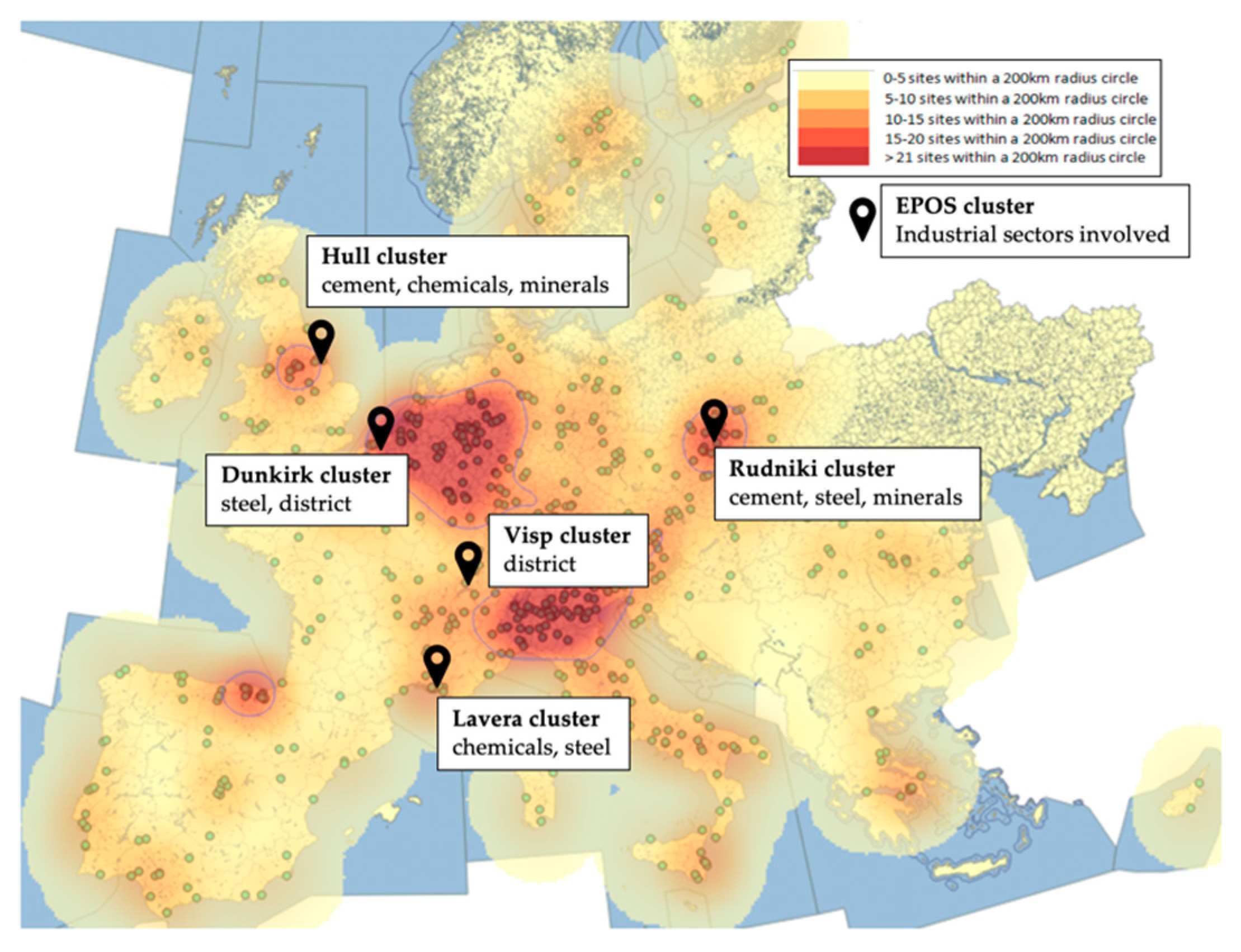
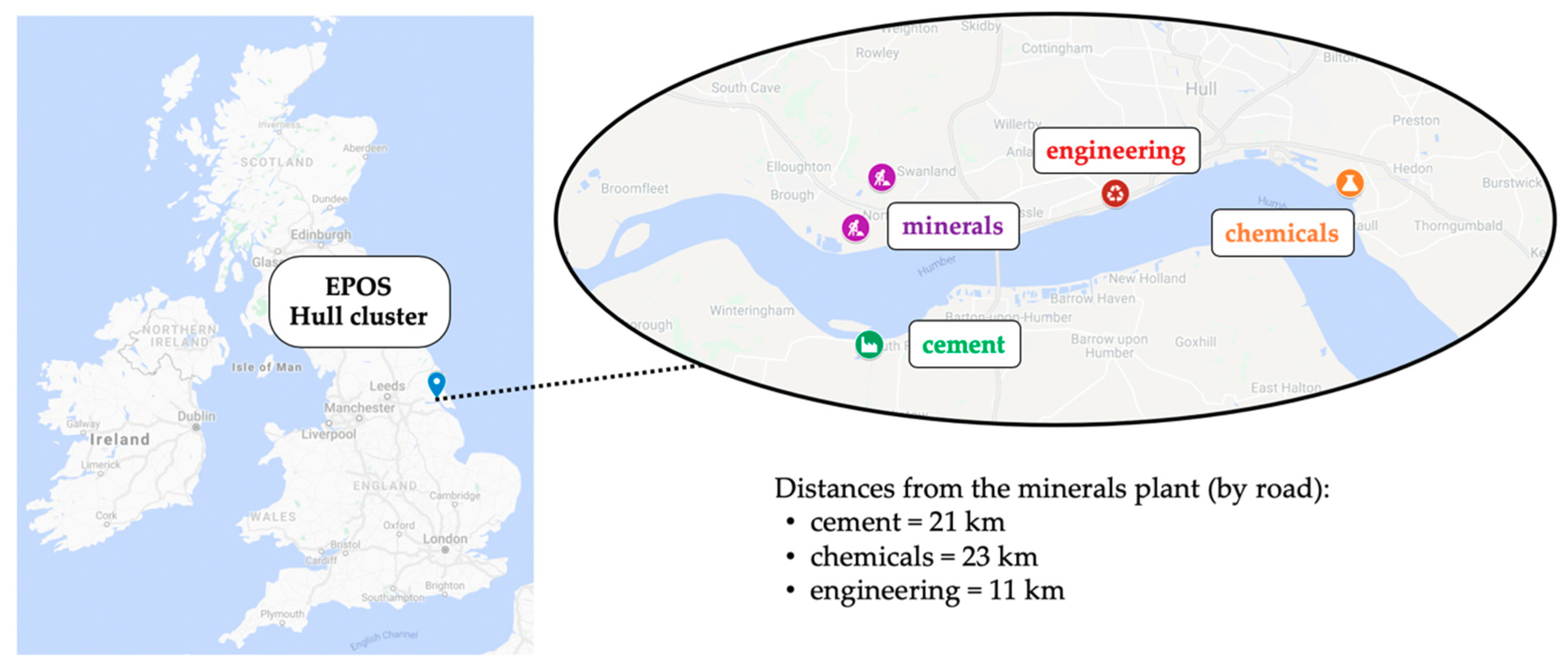
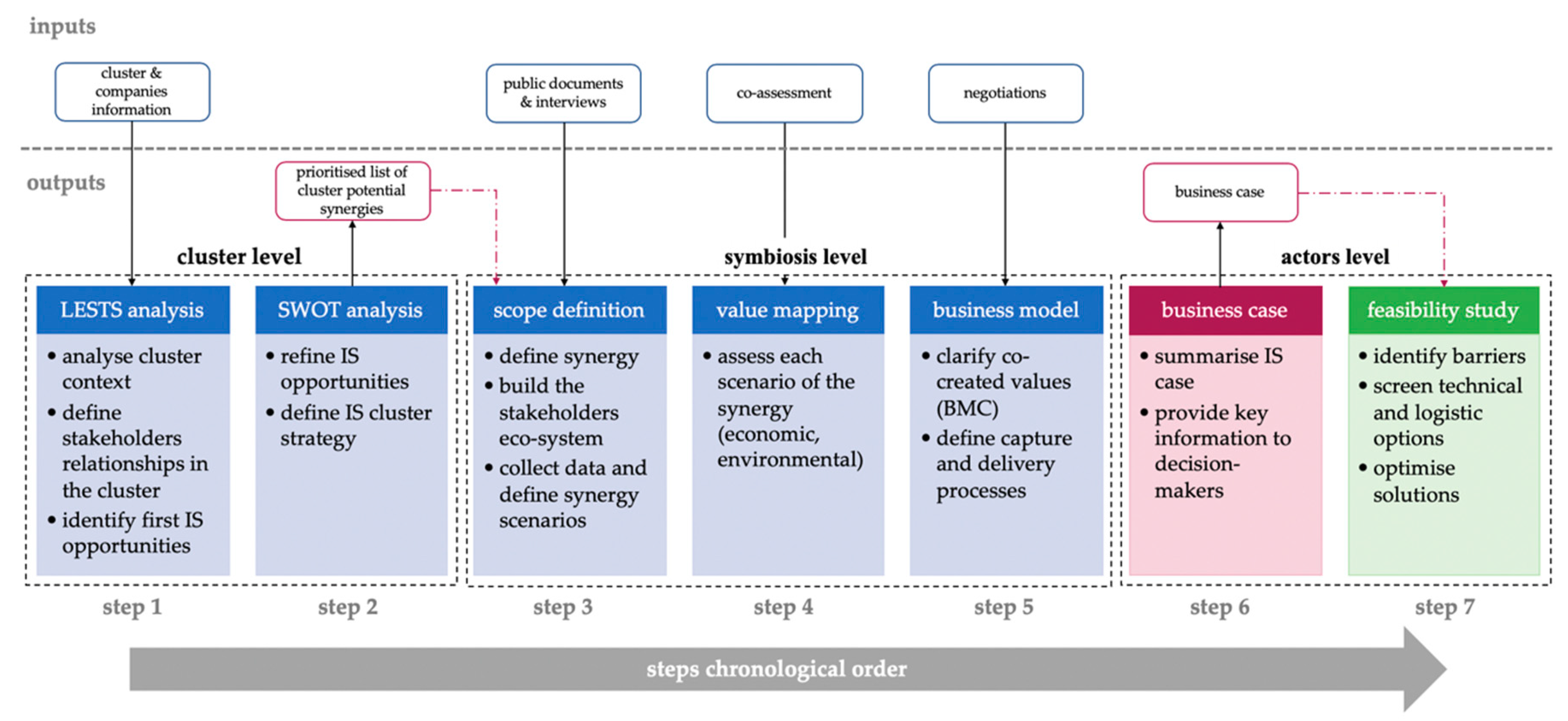
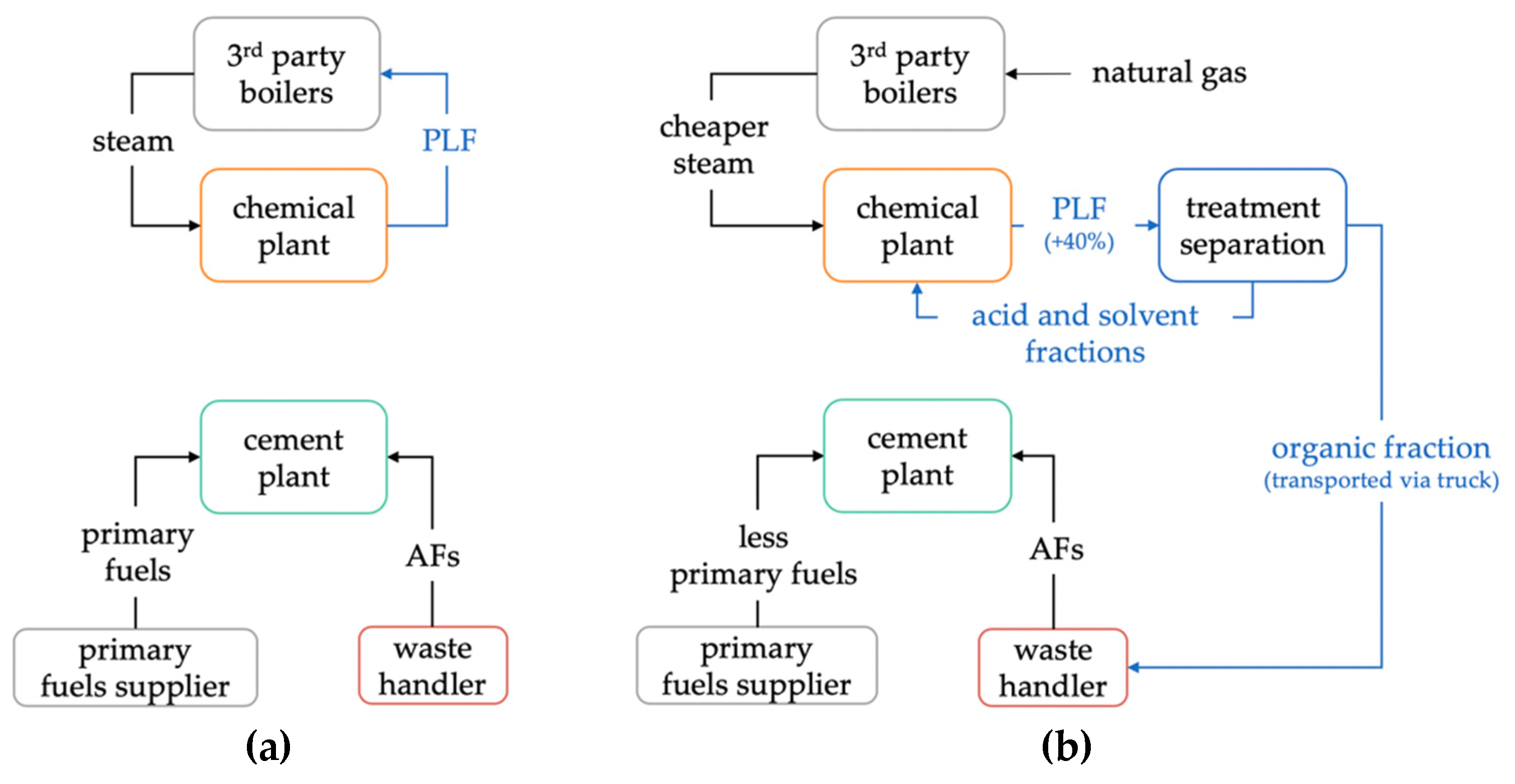
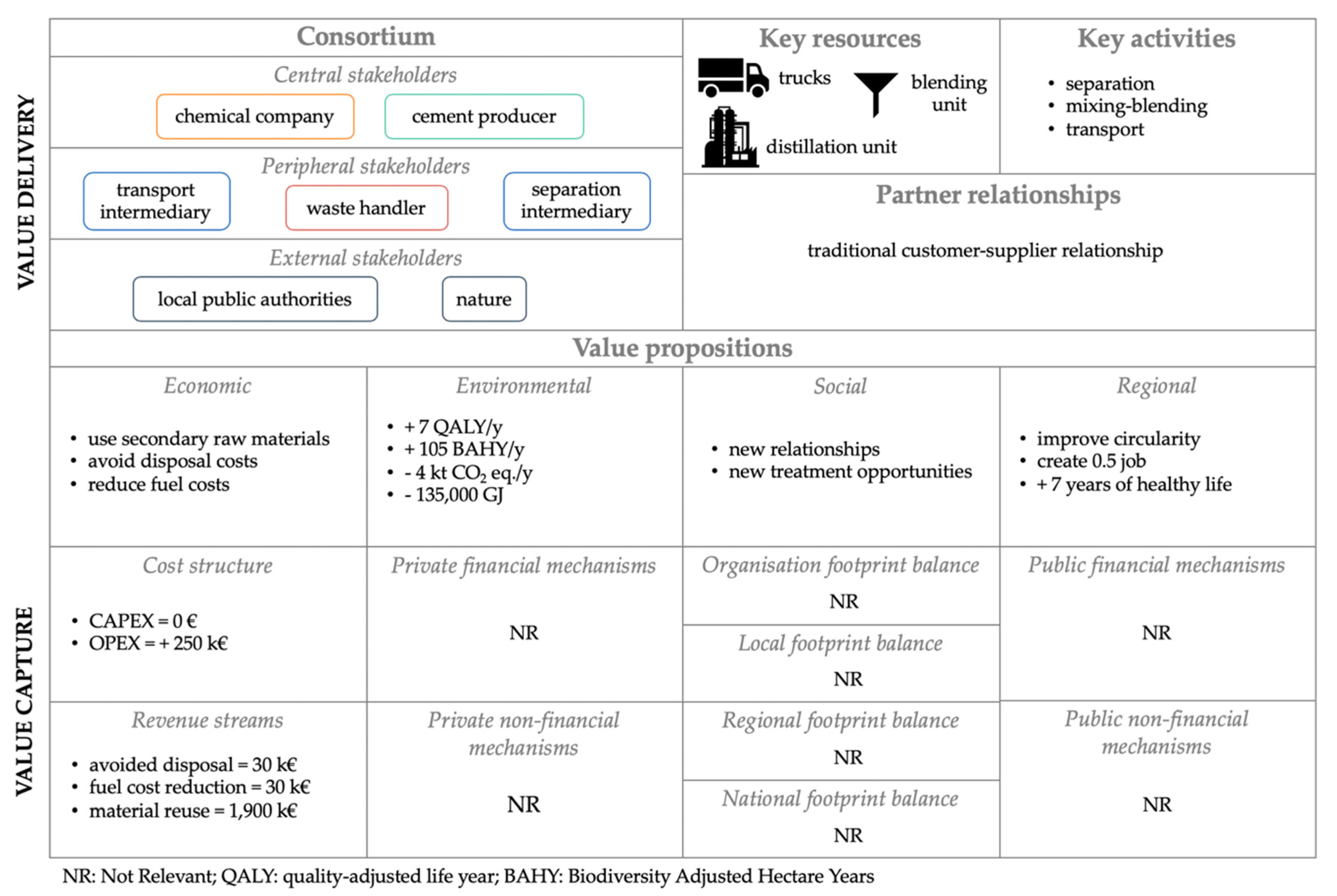
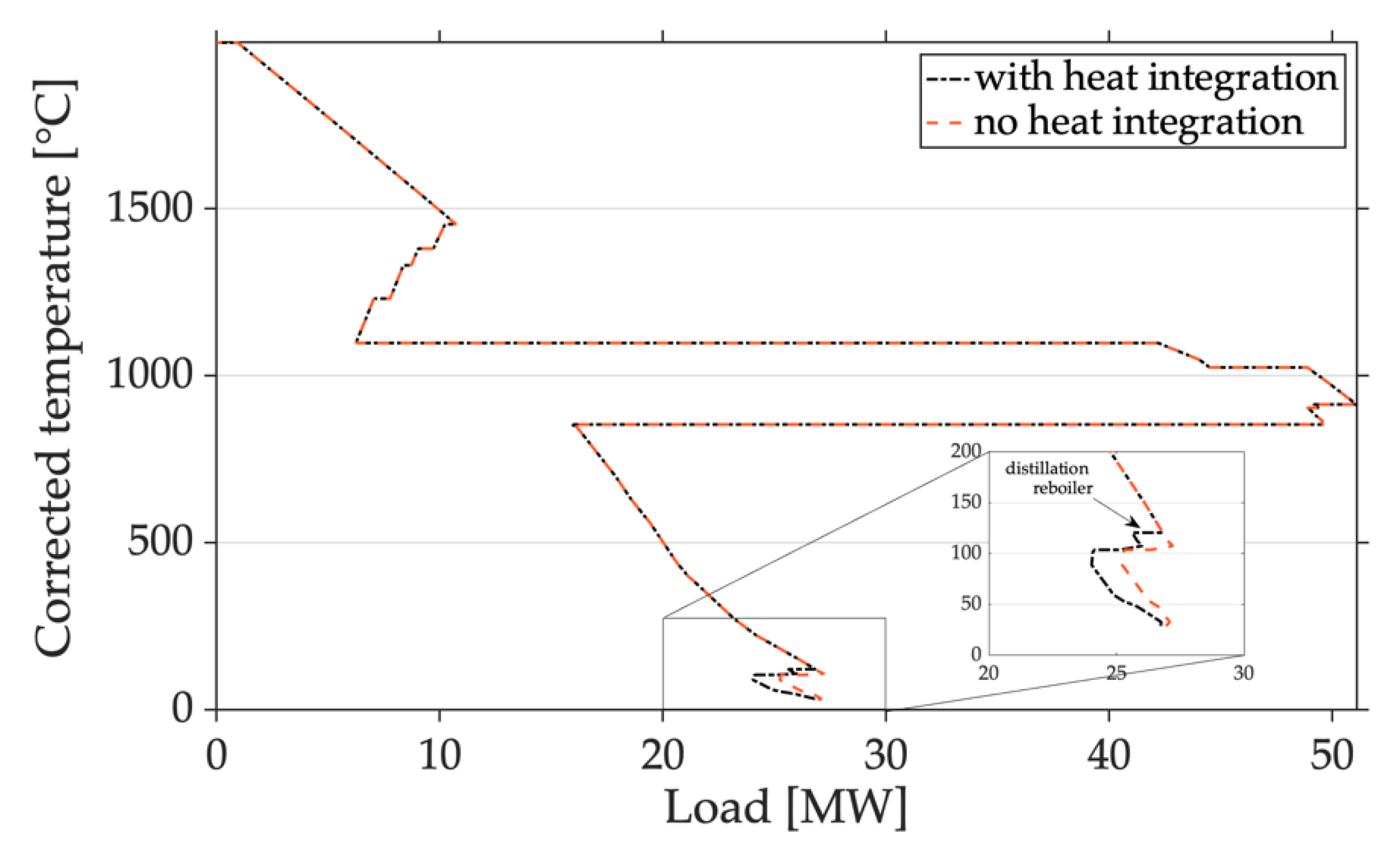
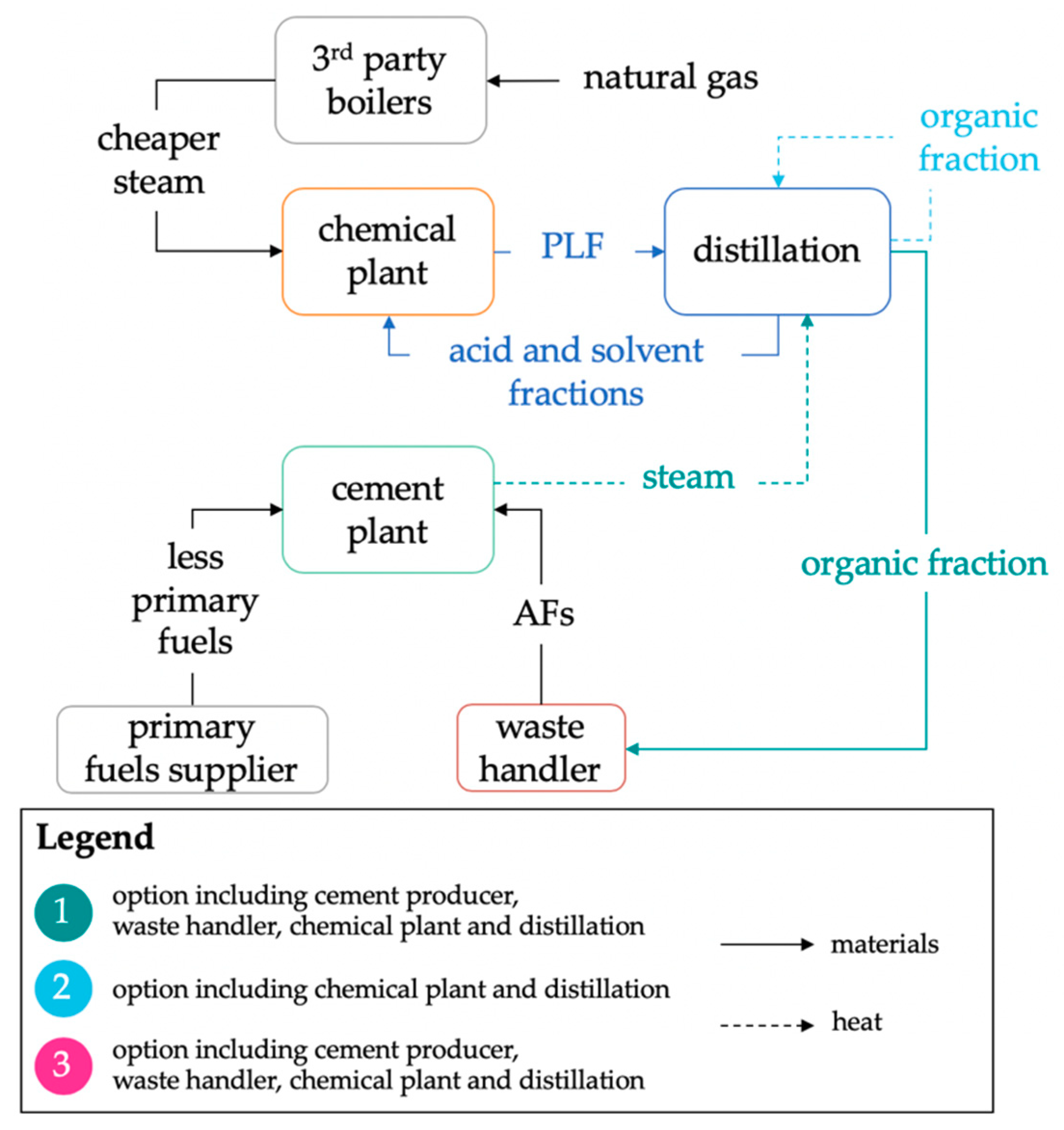
| IS Opportunity | Sender(s) | Receiver(s) | Interest Score a |
|---|---|---|---|
| Use PLF b stream as an AF c in cement kiln | Chemicals | Cement | 3.5 |
| Reuse calcium carbonate rich reject stream | Minerals | Cement | 3 |
| Cement Kiln Dust | Cement | Minerals | 3 |
| Capture CO2 and use it in a greenhouse | Cement, Minerals | Local community | 2.3 |
| Reuse spent catalyst | Chemicals | All industries | 2.3 |
| Install micro-turbines on the river Humber | All industries | Local community | 2.3 |
| Organise combined health and safety trainings | Engineering | All industries | 2.3 |
| Recover heat from exhaust gas | Minerals | Cement | 2 |
| Recover heat from condensates | Chemicals | All industries | 2 |
| Valorise low temperature heat with district heating network | Cement | Local community | 2 |
| Use excess cooling capacity | Chemicals | All industries | 1.7 |
| Recover heat from exhaust gas | Cement | All industries | 1.6 |
| Reuse cardboard, plastic, rubber wastes | Cement | All industries | 1.3 |
| Helpful (to Achieve the Object) | Harmful (to Achieve the Object) | |
|---|---|---|
| Internal origin |
|
|
| External origin |
|
|
| Description | Taken into Account | Remarks | |
|---|---|---|---|
| Positive values | Cost reduction for the chemical plant related to the steam procurement. | Yes | Noticeable but marginal in comparison with the value created by the internal reuse of the acid and solvent fractions of the PLF. |
| Cost reduction for the cement producer related to the use of a cheaper combustible (organic fraction of the PLF) compared to conventional fuels. | Yes | Noticeable but marginal in comparison with the value created by the internal reuse of the acid and solvent fractions of the PLF. | |
| Additional revenues for the chemical plant related to the sale of the PLF organic fraction. | Yes | They are assumed to be equal to zero, i.e., the organic fraction of the PLF stream is sent for free to the cement producer. | |
| Cost reduction for the chemical plant related to the internal reuse of the acid and solvent fractions. | Yes | Highest created values. | |
| Negative values | Treatment cost for separating and purifying the PLF stream. | Yes | Very low compared to the positive values created thanks to the internal reuse of the PLF acid and solvent fractions. |
| Management cost for handing and blending the PLF organic fraction with the cement producer AFs mix. | Yes | Negligible. | |
| Transportation cost for first conveying the stream to the treatment facility and then to the waste fuel provider of the cement producer. | Yes | Negligible. | |
| Revenue losses by the steam provider. | No | The PLF was initially generating issues with the steam boiler. The steam producer is thus satisfied by the symbiosis creation. Therefore, this negative value is not taken into account. | |
| Revenue losses by the conventional fuel provider of the cement producer. | No | Very low business impact. Therefore, it is neglected. | |
| Revenue losses of the raw materials suppliers of the chemical plant. | No | Very low business impact. Therefore, it is neglected. |
| Opportunity/Challenge | Recommendations | |
|---|---|---|
| Legal/policies | The PLF stream waste and hazardous status will require a modification in the fuel burning certification of the cement producer. This will represent an administrative burden. | Dedicate time to follow the administrative procedure and/or consult leading experts. |
| Economical/instruments | A decision from the board is required to validate the level of investment (payback time is exceeding 2 years). | Look for financial incentives. |
| Spatial/planning | Dangerous goods transported by road or waterway require special permits. | Take the dangerous status of the stream into account when choosing the third party that would be responsible for transporting the stream. |
| Technical/engineering | Expert opinion suggests that it is not possible to blend the PLF stream as it is with the fuel mix that is currently used by the cement producer. | Purify and separate the different fractions composing the PLF stream. |
| Problems with the cement burner are anticipated due to the high flammability of the PLF stream. | Consider different technology options for the burner such as adsorption on activated carbon. | |
| Thanks to the symbiosis, the environmental performance of both parties should be improved. | ||
| Social/responsibilities | The opportunity is detected in the framework of an H2020 EU project, which facilitates knowledge and information exchanges. | Put mechanisms in place to ensure the follow-up of the symbiosis implementation once the EPOS project is over. |
| Barriers | Solution | Remarks |
|---|---|---|
| Lack of commitment to sustainable development | Framework that allows the evaluation of the economic, environmental, social and regional values created or destroyed by the IS under consideration. Business case embedding essential information about the IS | The value of underutilised resources is generally poorly known by industries [53], thus the methodology contributes to raise awareness of decision-makers on the relevance to consider them as a new source of value. Highlights the whole set of values created by the IS (economic, environmental, social and regional). This business case can be drafted by an IS facilitator thus reducing the need for companies to dedicate specific resources for the opportunity identification and assessment [54,55]. |
| Lack of information sharing | Blueprints providing information about the flows of materials, energy, and services of a given industrial sector. Methodology that can be used by a trustworthy IS facilitator. | It facilitates data exchange without disclosing confidential information [57,58,93,94]. It facilitates the sharing of confidential data (non-disclosure agreements). |
| Lack of cooperation and trust | Co-assessment of values. Business model showing the distribution of benefits between stakeholders. | Opens discussion channels, creates trust and shows the benefits of cooperation. Benefits, risks, changes are highlighted in a clear and transparent way for all the stakeholders. |
| Lack of awareness from communities | Environmental, social and regional values are assessed in collaboration with the stakeholders, including the peripheral ones. | Public authorities, associations, communities are invited to assess the symbiosis which helps raising their awareness about the benefits it can create. |
| Economic infeasibility | Look at alternative possibilities besides the traditional market mechanisms. Extend the scope from IS to broader sustainability practices. | Other economic and non-market value transfer mechanisms are taken into account, which might trigger the IS economic feasibility. Can lead to the identification of sources with a greater value. |
© 2019 by the authors. Licensee MDPI, Basel, Switzerland. This article is an open access article distributed under the terms and conditions of the Creative Commons Attribution (CC BY) license (http://creativecommons.org/licenses/by/4.0/).
Share and Cite
Cervo, H.; Ogé, S.; Maqbool, A.S.; Mendez Alva, F.; Lessard, L.; Bredimas, A.; Ferrasse, J.-H.; Van Eetvelde, G. A Case Study of Industrial Symbiosis in the Humber Region Using the EPOS Methodology. Sustainability 2019, 11, 6940. https://doi.org/10.3390/su11246940
Cervo H, Ogé S, Maqbool AS, Mendez Alva F, Lessard L, Bredimas A, Ferrasse J-H, Van Eetvelde G. A Case Study of Industrial Symbiosis in the Humber Region Using the EPOS Methodology. Sustainability. 2019; 11(24):6940. https://doi.org/10.3390/su11246940
Chicago/Turabian StyleCervo, Hélène, Stéphane Ogé, Amtul Samie Maqbool, Francisco Mendez Alva, Lindsay Lessard, Alexandre Bredimas, Jean-Henry Ferrasse, and Greet Van Eetvelde. 2019. "A Case Study of Industrial Symbiosis in the Humber Region Using the EPOS Methodology" Sustainability 11, no. 24: 6940. https://doi.org/10.3390/su11246940
APA StyleCervo, H., Ogé, S., Maqbool, A. S., Mendez Alva, F., Lessard, L., Bredimas, A., Ferrasse, J.-H., & Van Eetvelde, G. (2019). A Case Study of Industrial Symbiosis in the Humber Region Using the EPOS Methodology. Sustainability, 11(24), 6940. https://doi.org/10.3390/su11246940






